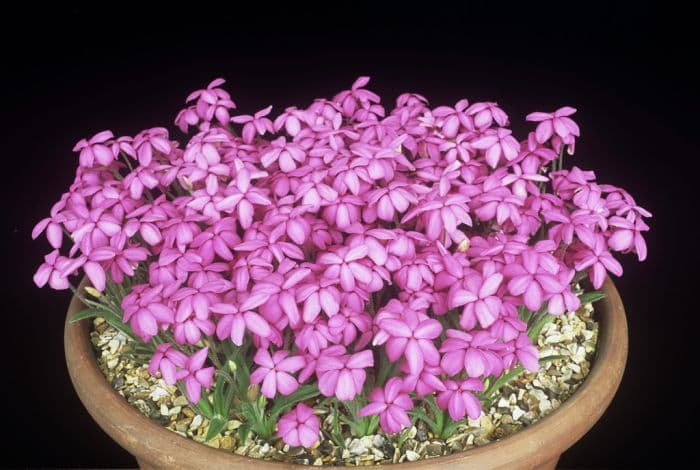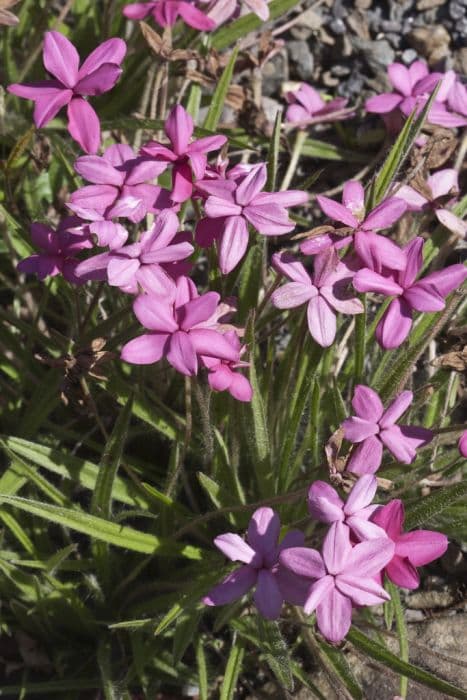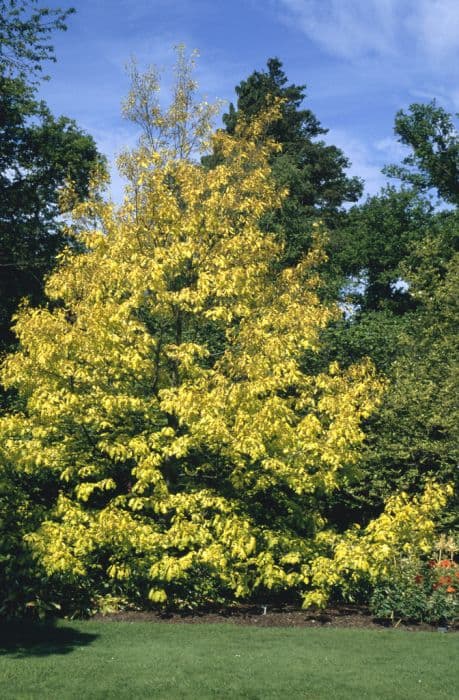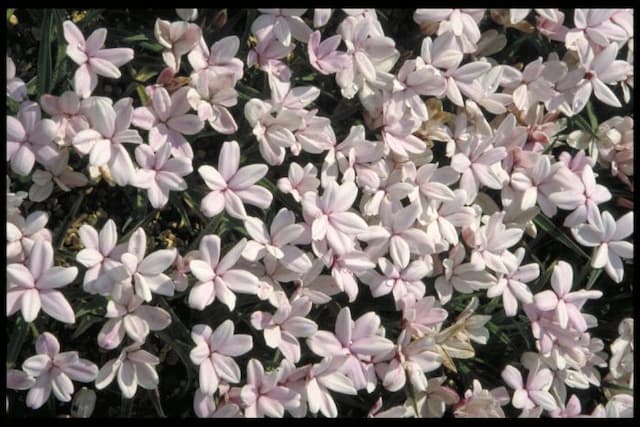Red Star Rhodohypoxis baurii 'Emily Peel'

ABOUT
Rhodohypoxis baurii 'Emily Peel' is a charming flowering plant that produces an attractive display of blooms. The plant has a clumping habit, with narrow, grass-like leaves that form a dense, lush green tuft. These leaves can provide a contrasting backdrop to its delightful flowers, which are the most striking feature of the plant. The blooms of 'Emily Peel' are star-shaped and come in a soft pink hue with a deeper pink center that tends to draw the eye. The petals are delicate and appear to have a slight crepe-like texture, which adds to their charm. The flowers cluster at the tips of the foliage, sitting just above the leaves, creating a lovely carpet of color when the plant is in full bloom. This ornamental plant also has a neat and tidy growth habit, making it an ideal candidate for borders, rock gardens, or as a specimen in small garden spaces. The overall appearance of Rhodohypoxis baurii 'Emily Peel' exudes a gentle beauty that can enhance the aesthetic of any garden setting with its soft color palette and pleasing floral display.
About this plant
 Names
NamesFamily
Hypoxidaceae.
Synonyms
Red Star, Rhodohypoxis 'Emily Peel'.
Common names
Rhodohypoxis baurii 'Emily Peel'.
 Toxicity
ToxicityTo humans
Rhodohypoxis baurii 'Emily Peel', commonly known as Rhodohypoxis, is not widely known to be toxic to humans. There is limited information on its toxicity, and it does not typically appear on lists of poisonous plants. Consequently, if ingestion does occur, there may not be any significant symptoms associated with poisoning. It's always wise, however, to exercise caution and keep non-food plants out of the reach of children, as individual sensitivities can vary.
To pets
The common Rhodohypoxis is not widely recognized as a toxic plant to pets. Information regarding its toxicity is scarce, and it is not commonly listed among the plants known to be poisonous to pets such as dogs and cats. Therefore, if a pet were to ingest Rhodohypoxis, it is unlikely to cause poisoning. Nonetheless, it is generally recommended to prevent pets from consuming plants that are not intended for animal consumption, as individual reactions can differ.
 Characteristics
CharacteristicsLife cycle
Perennials
Foliage type
Deciduous
Color of leaves
Green
Flower color
Pink
Height
3-4 inches (7.5-10 cm)
Spread
3-4 inches (7.5-10 cm)
Plant type
Bulb
Hardiness zones
7
Native area
South Africa
Benefits
 General Benefits
General Benefits- Ornamental Value: Produces charming pink or white star-shaped flowers, enhancing the aesthetic appeal of gardens and outdoor spaces.
- Low Maintenance: Requires minimal care once established, making it suitable for gardeners of all skill levels.
- Compact Size: Its small stature allows for easy integration into rock gardens, borders, and containers.
- Drought Tolerance: Once established, it can withstand periods of dry weather, reducing the need for frequent watering.
- Attracts Pollinators: The flowers attract insects such as bees, supporting local pollinator populations.
- Seasonal Interest: Blooms in late spring to summer, providing seasonal color and interest in the garden.
- Ground Cover: Can be used as a ground cover to fill spaces and suppress weeds with its dense foliage.
- Cold Hardy: Capable of surviving in cooler climates, making it a versatile plant for various landscape zones.
 Medical Properties
Medical PropertiesThis plant is not used for medical purposes.
 Air-purifying Qualities
Air-purifying QualitiesThis plant is not specifically known for air purifying qualities.
 Other Uses
Other Uses- Rhodohypoxis baurii 'Emily' can be used in dollhouse gardens due to its miniature size, giving a realistic and scaled-down appearance of a full-sized garden.
- The plant can be integrated into wedding decorations, such as table centerpieces or boutonnieres, for a touch of natural and delicate beauty.
- It can be used in photographic projects or macro photography to provide a vibrant and detailed subject thanks to its bright flowers.
- The plant's clumping nature makes it suitable for fairy gardens, adding to the whimsical aesthetic with its small stature and colorful blooms.
- Crafters may use dried flowers of Rhodohypoxis baurii 'Emily' in making bookmarks or pressed flower art, preserving its beauty in a unique way.
- The plant can be utilized in educational settings to teach children about plant life cycles, due to its relatively fast flowering period.
- It can be a living gift for special occasions such as Mother's Day or anniversaries, symbolizing affection and appreciation with its bright appearance.
- In theme parks or miniature displays, the plant can create realistic sceneries for model train setups or other small-scale dioramas.
- The vibrant color of Rhodohypoxis baurii 'Emily' can be used for color therapy or simply to provide an uplifting and bright atmosphere in a room.
- Since the plant is small and manageable, it can serve as a starter plant for teaching beginners the basics of gardening and plant care.
Interesting Facts
 Feng Shui
Feng ShuiThe Red Star is not used in Feng Shui practice.
 Zodiac Sign Compitability
Zodiac Sign CompitabilityThe Red Star is not used in astrology practice.
 Plant Symbolism
Plant Symbolism- Delicacy: Rhodohypoxis baurii 'Emily Peel', commonly known as Red Star, often symbolizes delicacy due to its small and delicate star-shaped flowers.
- Pure Beauty: The pure and bright colors of the Red Star's blooms are associated with simple and unadulterated beauty.
- New Beginnings: As a plant that emerges with vibrant growth each spring, the Red Star is often seen as a representation of new beginnings and rebirth.
- Adaptability: This plant's ability to thrive in a variety of conditions can symbolize resilience and adaptability in life.
- Love and Passion: The Red Star's vivid red flowers are sometimes connected with love and deep passion, similar to other red flowers like roses.
 Water
WaterRhodohypoxis, commonly referred to as Red Star, requires regular watering during its active growth in spring and summer. Ensure the soil is consistently moist, watering with about 8 ounces of water once or twice a week depending on the temperature and humidity. It's crucial to reduce watering in the winter when the plant goes dormant, providing just enough water to prevent the soil from completely drying out.
 Light
LightRed Star thrives in bright, indirect sunlight. The ideal spot is where it gets morning sun and partial shade in the afternoon, protecting it from the intense midday sun which can scorch its leaves.
 Temperature
TemperatureRed Star prefers cooler temperatures and can generally withstand a temperature range from 40 to 75 degrees Fahrenheit. The ideal temperature for this plant is between 50 and 65 degrees Fahrenheit. It should be protected from frost and extreme heat.
 Pruning
PruningRed Star benefits from pruning to remove spent flowers and dead foliage, encouraging healthier growth and better blooming. This is best done after flowering in late summer. Pruning is infrequent, generally only necessary annually.
 Cleaning
CleaningAs needed
 Soil
SoilThe Red Star plant thrives in a well-draining, acidic to neutral potting mix with a pH between 5.5 and 7. A mix comprising equal parts of loam, sand or perlite, and peat or leaf mold will support healthy growth, ensuring good drainage and aeration.
 Repotting
RepottingRed Star plants generally need repotting every two to three years. It's best to repot in the spring before new growth starts. Use a slightly larger pot each time to accommodate root growth.
 Humidity & Misting
Humidity & MistingRed Star plants prefer moderate humidity levels. While they can adapt to indoor environments, it's beneficial to maintain a humidity level of around 40-50% for optimal growth.
 Suitable locations
Suitable locationsIndoor
Place in bright, indirect light and keep soil lightly moist.
Outdoor
Plant in partial shade, protect from harsh sun and frost.
Hardiness zone
7-9 USDA
 Life cycle
Life cycleRhodohypoxis baurii 'Emily Peel', also known as Red Star, begins its life cycle as a dormant corm during winter. In spring, the corm breaks dormancy and sprouts, producing narrow, grass-like leaves. Throughout late spring to summer, the plant blooms with star-shaped pink flowers that attract pollinators. After flowering, the Red Star sets seed, which can be dispersed to propagate new plants. As autumn approaches, the leaves die back, and the plant re-enters dormancy, conserving energy within the corm. The cycle repeats each year with the corm enlarging and potentially producing offsets that can be separated to create new plants.
 Propogation
PropogationPropogation time
Spring to Summer
Rhodohypoxis baurii 'Emily Peel', commonly known as the Rose Grass or Rhodohypoxis, is typically propagated through division, which is best done in spring as the plant is emerging from dormancy. To propagate through division, carefully lift the clump of plants from the ground and gently separate the corm-like structures at their natural dividing points, ensuring that each new section has at least one growing point. Replant the divisions at a depth of about 1 inch (approximately 2.54 cm) in well-draining soil, spacing them several inches apart. Water the newly planted divisions gently to settle the soil around them and keep the soil moderately moist until they establish. This method is favored due to its simplicity and effectiveness in producing new plants identical to the parent.
![Rhodoxis [Fairytale]](/_next/image?url=https%3A%2F%2Fplants-admin.emdemapps.com%2Fimages%2Fplants%2F%2Fimages%2F604b54204420d.png&w=640&q=75)



